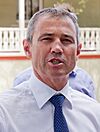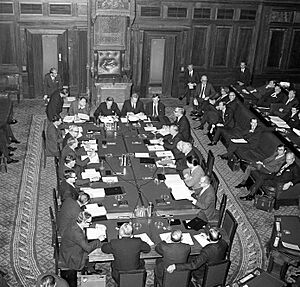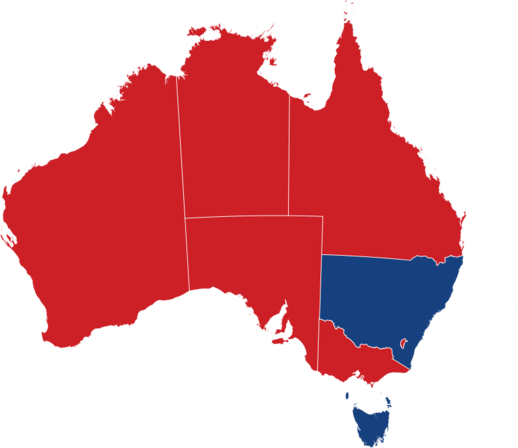Premiers and chief ministers of the Australian states and territories facts for kids
The premiers and chief ministers of the Australian states and territories are the main leaders of the government in Australia's six states and two self-governing territories. They do a similar job for their state or territory as the Prime Minister of Australia does for the whole country.
Australia has a King, and each state has a Governor. These people formally hold the power, but they usually only act on the advice of the premier or chief minister and their team of ministers. They only step in on their own in very unusual situations, like a big problem with the rules of government.
Contents
How Leaders Are Chosen
Each Australian state uses a system of government called the Westminster system. This means each state has a parliament with elected members. After an election, the state Governor chooses a premier. This person is usually the leader of the political party that has the most votes in the lower house of the state parliament.
The Governor is like the head of the state, but they follow the advice of the premier, who is the head of the government. A premier must step down if their party loses an election or if they lose the support of the parliament. Premiers can also resign for other reasons, like if their own party no longer supports them.
Australia's states started as British colonies. At first, a Governor appointed by the British government held all the power. Over time, this power slowly moved to elected groups of people. By the late 1800s, all states had their own fully elected governments.
In the early days, Australian politics didn't have strong political parties. Leaders often formed governments based on friendships or small groups, and governments changed very often. Politics could sometimes be messy.
However, when the Australian Labor Party became strong in the 1890s, it pushed the states towards having two main political sides: Labor and non-Labor. Since about 1910, state politics have generally followed a similar pattern to national politics in Australia.
Since 1952, almost every premier in every state has belonged to one of three main parties: the Australian Labor Party, the Liberal Party of Australia, or the National Party of Australia.
The rules for what states can do are written in the Constitution of Australia. However, the power of state premiers has slowly become less since Australia became a nation in 1901. This is because the national government has taken on more responsibilities. For example, during World War II in 1943, states gave up their power to collect their own income taxes to the national government. This means the national government now largely controls state finances.
Working Together: Premiers and Other Governments
For many years, state premiers and the prime minister met at special events called Premiers' Conferences. From 1992 to 2020, these meetings happened through the Council of Australian Governments (COAG). This group included chief ministers from the territories and a representative from local councils.
Since 2020, a group called the National Cabinet allows the prime minister, state premiers, and territory chief ministers to meet. This helps them work together on important issues for Australia.
Current Premiers of the States
Map showing the states of Australia and their governing political parties: Labor Liberal (includes the Country Liberal and Liberal National parties)
| State | Portrait | Name | Term start | Current duration | Party | Title | State government | |
|---|---|---|---|---|---|---|---|---|
 |
Chris Minns | 28 March 2023 | 2 years, 265 days | Labor | Premier | New South Wales Government |
||
 |
Jacinta Allan | 27 September 2023 | 2 years, 82 days | Labor | Premier | Allan government | ||
 |
David Crisafulli | 28 October 2024 | 1 year, 51 days | Liberal National | Premier | Premiership of David Crisafulli | ||
 |
Roger Cook | 8 June 2023 | 2 years, 193 days | Labor | Premier | Western Australia Government |
||
 |
Peter Malinauskas | 21 March 2022 | 3 years, 272 days | Labor | Premier | South Australia Government |
||
 |
Jeremy Rockliff | 8 April 2022 | 3 years, 254 days | Liberal | Premier | Premiership of Jeremy Rockliff | ||
Current Chief Ministers of the Territories
| Territory | Portrait | Name | Term start | Current duration | Party | Title | Territory government | |
|---|---|---|---|---|---|---|---|---|
Capital Territory |
 |
Andrew Barr | 11 December 2014 | 11 years, 7 days | Labor | Chief Minister | Australian Capital Territory Government |
|
 |
Lia Finocchiaro | 28 August 2024 | 1 year, 112 days | Country Liberal | Chief Minister | Chief ministership of Lia Finocchiaro | ||
Female Heads of Government
Almost every state and territory in Australia has had a female head of government. Most of these women have been from the Australian Labor Party. Here are some of them:
- Australian Capital Territory:
- Rosemary Follett (1989, 1991–1995) – She was the first woman to lead a government in any Australian territory or state.
- Kate Carnell (1995–2000)
- Katy Gallagher (2011–2014)
- Western Australia:
- Carmen Lawrence (1990–1993) – She was the first woman to be a state premier.
- Victoria:
- Joan Kirner (1990–1992)
- Jacinta Allan (2023–present)
- Northern Territory:
- Clare Martin (2001–2007)
- Natasha Fyles (2022–2023)
- Eva Lawler (2023–2024)
- Lia Finocchiaro (2024–present)
- Queensland:
- Anna Bligh (2007–2012)
- Annastacia Palaszczuk (2015–2023)
- New South Wales:
- Kristina Keneally (2009–2011)
- Gladys Berejiklian (2017–2021)
- Tasmania:
- Lara Giddings (2011–2014)
Many of these women became premier or chief minister when the male leader of their party resigned. Anna Bligh, Annastacia Palaszczuk, and Gladys Berejiklian are the only women who have won an election as premier of an Australian state. Annastacia Palaszczuk is also the only woman to lead her party from being out of government to winning an election and forming a government.
Women have also been elected as chief ministers in the Australian Capital Territory (ACT) and the Northern Territory (NT). Rosemary Follett was the first Chief Minister of the ACT in 1989. Kate Carnell and Clare Martin also won elections as chief ministers.
Only Clare Martin and Annastacia Palaszczuk have been re-elected after serving a full term. Rosemary Follett won two elections, but her time as chief minister was interrupted for a period.
See also
- List of Australian heads of government by time in office



